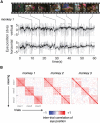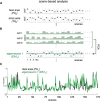Single-unit activity during natural vision: diversity, consistency, and spatial sensitivity among AF face patch neurons
- PMID: 25855170
- PMCID: PMC4388919
- DOI: 10.1523/JNEUROSCI.3825-14.2015
Single-unit activity during natural vision: diversity, consistency, and spatial sensitivity among AF face patch neurons
Abstract
Several visual areas within the STS of the macaque brain respond strongly to faces and other biological stimuli. Determining the principles that govern neural responses in this region has proven challenging, due in part to the inherently complex stimulus domain of dynamic biological stimuli that are not captured by an easily parameterized stimulus set. Here we investigated neural responses in one fMRI-defined face patch in the anterior fundus (AF) of the STS while macaques freely view complex videos rich with natural social content. Longitudinal single-unit recordings allowed for the accumulation of each neuron's responses to repeated video presentations across sessions. We found that individual neurons, while diverse in their response patterns, were consistently and deterministically driven by the video content. We used principal component analysis to compute a family of eigenneurons, which summarized 24% of the shared population activity in the first two components. We found that the most prominent component of AF activity reflected an interaction between visible body region and scene layout. Close-up shots of faces elicited the strongest neural responses, whereas far away shots of faces or close-up shots of hindquarters elicited weak or inhibitory responses. Sensitivity to the apparent proximity of faces was also observed in gamma band local field potential. This category-selective sensitivity to spatial scale, together with the known exchange of anatomical projections of this area with regions involved in visuospatial analysis, suggests that the AF face patch may be specialized in aspects of face perception that pertain to the layout of a social scene.
Keywords: eigenneurons; fMRI; macaque; movies; natural vision; single units.
Figures








Similar articles
-
Tolerance of macaque middle STS body patch neurons to shape-preserving stimulus transformations.J Cogn Neurosci. 2015 May;27(5):1001-16. doi: 10.1162/jocn_a_00762. Epub 2014 Nov 12. J Cogn Neurosci. 2015. PMID: 25390202
-
Neural Correlate of the Thatcher Face Illusion in a Monkey Face-Selective Patch.J Neurosci. 2015 Jul 8;35(27):9872-8. doi: 10.1523/JNEUROSCI.0446-15.2015. J Neurosci. 2015. PMID: 26156988 Free PMC article.
-
Translation invariance in the responses to faces of single neurons in the temporal visual cortical areas of the alert macaque.J Neurophysiol. 1994 Sep;72(3):1049-60. doi: 10.1152/jn.1994.72.3.1049. J Neurophysiol. 1994. PMID: 7807195
-
Computational approaches to human pattern recognition.Spat Vis. 1994;8(1):57-76. doi: 10.1163/156856894x00242. Spat Vis. 1994. PMID: 8049170 Review.
-
An egocentric straight-ahead bias in primate's vision.Brain Struct Funct. 2021 Dec;226(9):2897-2909. doi: 10.1007/s00429-021-02314-8. Epub 2021 Jun 13. Brain Struct Funct. 2021. PMID: 34120262 Free PMC article. Review.
Cited by
-
Common functional localizers to enhance NHP & cross-species neuroscience imaging research.Neuroimage. 2021 Aug 15;237:118203. doi: 10.1016/j.neuroimage.2021.118203. Epub 2021 May 25. Neuroimage. 2021. PMID: 34048898 Free PMC article.
-
Whole-agent selectivity within the macaque face-processing system.Proc Natl Acad Sci U S A. 2015 Nov 24;112(47):14717-22. doi: 10.1073/pnas.1512378112. Epub 2015 Oct 13. Proc Natl Acad Sci U S A. 2015. PMID: 26464511 Free PMC article.
-
Inactivation of face-selective neurons alters eye movements when free viewing faces.Proc Natl Acad Sci U S A. 2024 Jan 16;121(3):e2309906121. doi: 10.1073/pnas.2309906121. Epub 2024 Jan 10. Proc Natl Acad Sci U S A. 2024. PMID: 38198528 Free PMC article.
-
Temporal continuity shapes visual responses of macaque face patch neurons.Neuron. 2023 Mar 15;111(6):903-914.e3. doi: 10.1016/j.neuron.2022.12.021. Epub 2023 Jan 10. Neuron. 2023. PMID: 36630962 Free PMC article.
-
Local features drive identity responses in macaque anterior face patches.Nat Commun. 2022 Sep 23;13(1):5592. doi: 10.1038/s41467-022-33240-w. Nat Commun. 2022. PMID: 36151142 Free PMC article.
References
Publication types
MeSH terms
Substances
Grants and funding
LinkOut - more resources
Full Text Sources
